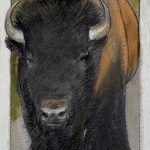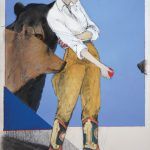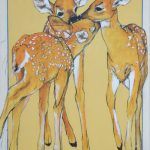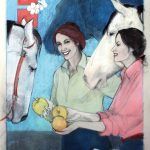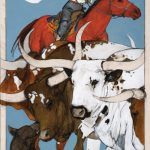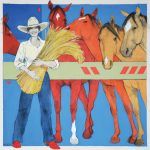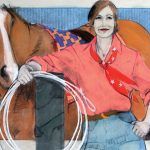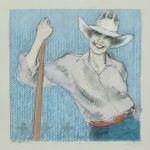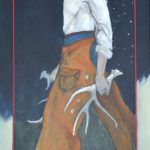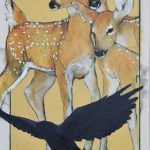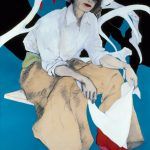Donna Howell-Sickles reimagines the cowgirl as a super-woman for every era
By Gussie Fauntleroy
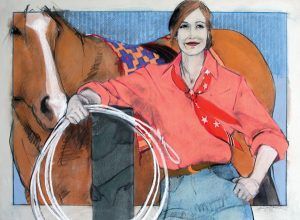
Donna Howell-Sickles, The Stars at Night, mixed media, 22 x 30.
This story was featured in the August 2016 issue of Southwest Art magazine. Get the Southwest Art August 2016 print issue or digital download now–then subscribe to Southwest Art and never miss another story.
In Donna Howell-Sickles’ eyes, the distance between the goddess of ancient mythology and a smiling, ruby-lipped western cowgirl astride a prancing horse is not nearly as far as one might think. Both are strong, confident, self-actualized women. Both are fabled figures that arose from agrarian cultures with an essential connection between humans, animals, and the land. For Howell-Sickles, the cowgirl has served as a metaphor for stories about spirited, wise, competent women, and the human experience in general, for more than 35 years. Although the women in her art have evolved over the years, becoming more individualized and representing more nuanced tales, what has remained constant is their infectious feeling of enthusiasm and joy. It’s a quality reinforced by fields of bold color, dynamic visual movement, and traces of underlying drawing that have always characterized her work.
In a sense, the charismatic cowgirl is the precursor to powerful, strong-minded female superheroes that girls today can dress up and pretend to be, Howell-Sickles points out. Boys have always had costumed heroes offering role models for valor and strength, but a fringed skirt and boots were among the few ways young girls could try on an empowering alter ego when the artist was a child. Born in 1949 and raised on a north Texas farm, she didn’t think of herself as western at the time. But she had an adventurous, energetic spirit, roaming the creeks, playing with baby farm animals, helping with chores. She was always exposed to strong women of the hardworking, can-do type. “I think I was lucky to be in a farming community. Everyone there worked—worked the land, worked the garden, cooked, went to church. There was no room for helplessness; it was not even an option,” she remembers. Rather than a single role model on whom her concept of female competence was based, she tucked away ideas in “bits and pieces from lots of women. I always saw women as essential, and in my world, they were.”
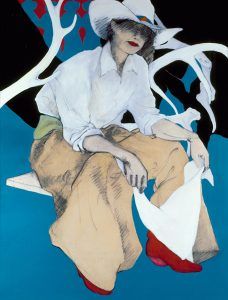
Donna Howell-Sickles, White Horns, acrylic, 48 x 36.
Art, on the other hand, was not an everyday part of Howell-Sickles’ childhood. The schools she attended offered no art classes, even in high school, and no one she knew was professionally involved in art. But she was fascinated by illustrations in magazines and books and was good at drawing. When she was in elementary school, both her parents decided to leave the farm operation to others and find a livelihood that didn’t rely on rain. They returned to school, earned master’s degrees in education, and became schoolteachers. When it came time for Donna to enter college at Texas Tech University in Lubbock, she followed her parents’ example and enrolled as an education major.
During her junior year, however, something unexpected happened. Assigned general art classes as preparation for teaching young students introductory crafts and art, she found herself in the college’s art building for the first time. “Suddenly I was surrounded by people more like me than anyone I had ever met in my life,” she says. “Before that, I’d been trying to accept the fact that I was just odd. So to find others who were my kind of odd was very liberating.” The following semester Howell-Sickles quietly dropped her education courses and signed up for only art classes, not telling her parents until she knew it was too late to change back without additional fees. Her parents were not happy, but the strategy worked. She graduated with a bachelor’s in fine art, but not before another seemingly small but ultimately seismic event took place, which set her on her life’s artistic path. A fellow art student gave her an old postcard, circa 1935. It featured a picture of a waving, vivacious, Hollywood-style cowgirl, and underneath were the words: “Greetings from a Real Cowgirl From the Ole Southwest!” The picture intrigued her, although it took her years to fully understand why. But what she immediately saw was a door to western-themed painting that connected to her personal history, with a contemporary approach. In conservative 1970s Texas it also offered a way to tell stories of self-sufficient women without stepping on male toes.
Following graduation, Howell-Sickles spent two years in Washington state with the National Arts Enrichment Program, serving as a visiting artist in rural schools. When that gig was over in 1979, she returned to her family’s farm. “I thought I was making a pit stop in Texas to regroup. In my mind I was headed to Santa Fe to work and live,” she says. But she never made it to Santa Fe. Instead, she set up a studio on the back porch at the farm, met and married John Sickles, and with his encouragement and support, began exploring the cowgirl in her art. “I just jumped right in and decided I would make it work,” she says.
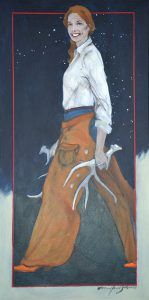
Donna Howell-Sickles, Into the West, acrylic, 24 x 12.
She also began reading about early 1900s women who actually supported themselves as cowgirls on the professional rodeo circuit and in Wild West shows. Intriguing entertainers representing independence most women didn’t have at the time, cowgirls were a big hit in cities from New York to Berlin. “They were women riding broncs in split skirts in front of crowds with corsets and lace gloves,” Howell-Sickles says. The fantasy figure that spun off from that phenomenon personified a dauntless woman who could rope and ride yet still be femininely alluring with her lipstick smile. “The cowgirl image was used to sell everything from coffee to sex from the Victorian era on,” she says.
In her early paintings Howell-Sickles exaggerated the fun-loving, fictionalized image of the cowgirl by leaving the figures faceless except for their bright red lips. As she learned about the women of early rodeos and Wild West shows, her work shifted to reflect a more thoughtful approach. She began using models for the women in her paintings, giving them individual personalities and placing them in context with symbolism and stories from folk tales and ancient mythology. “All the parts came together at the same time,” she says. “I realized the cowgirl could be a vehicle for telling the stories of all women.”
Among those stories is that of the wise woman who sees beneath the surface of things to the ancient network of intertwined connections—between life and death and among wisdom traditions from diverse cultures and times. “There’s lot of magic, a lot of unexplained aspects of life out there,” Howell-Sickles says.
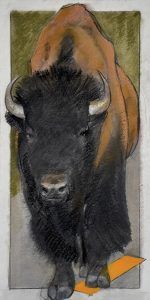
Donna Howell-Sickles, Bison Bull, charcoal, 60 x 40.
Virtually all of her art combines multiple mediums, including charcoal, Prismacolor pencils, soft pastel, graphite, and acrylic. Canine companions are a common theme in her work, and she and her husband currently have one dog, Rubie. The Australian shepherd roams the couple’s ranch northwest of Dallas, with its rolling hills, oak trees, creeks, and star-filled night skies. The property is close to the small town of Saint Jo, which was founded by Howell-Sickles’ great-great-uncle Joseph Anderson Howell and a partner following the Civil War. Not far from Howell Street on the town square, a restored mid-1880s building houses Davis & Blevins Gallery, which Donna and John own. Her studio is upstairs, a generous, light-filled space with eight large windows overlooking the square and almost as many easels bearing works in progress at any time. A couple of partially finished small clay sculptures remind the artist of her interest in exploring three dimensions; they wait patiently for when she’ll have time to return to them. Another new direction involves paintings in which the cowgirl is absent, replaced by a single magnificent animal, often a bison or deer. “They have such presence,” she says of the wild creatures, adding that these pieces are “tons of fun to do.”
One central aspect of Howell-Sickles’ art has not changed over the years. As expressed through her cowgirls’ ever-smiling eyes and vibrant poise, her work consistently conveys a sense of contentment, humor, and warmth—a reflection of the artist’s own deep love of life. In the legends and mythology that feed her imagery, there is plenty of sorrow and angst, but it’s not where she chooses to focus her attention. “I celebrate the now and the joy we can feel in being who we are, and where we are, at this exact moment,” she says. “What makes us joyous is different for each person, but to me that’s what makes life worth it.”
representation
Big Horn Galleries, Cody, WY; Davis & Blevins Gallery, Saint Jo, TX; McLarry Fine Art, Santa Fe, NM; Mountain Trails Gallery, Jackson, WY, and Park City, UT.
Featured in the August 2016 issue of Southwest Art magazine. Get the Southwest Art August 2016 print issue or digital download now–then subscribe to Southwest Art and never miss another story.
- Donna Howell-Sickles, Bison Bull, charcoal, 60 x 40.
- Donna Howell-Sickles, Don’t Feed the Bears, mixed media, 60 x 40.
- Donna Howell-Sickles, Gentle Greetings, acrylic/charcoal, 36 x 29.
- Donna Howell-Sickles, If There Had Been Three Could He Have Cheated Fate?, mixed media, 44 x 30.
- Donna Howell-Sickles, Stampede, acrylic, 60 x 48.
- Donna Howell-Sickles, Standing With the Girls, acrylic, 57 x 57.
- Donna Howell-Sickles, The Stars at Night, mixed media, 22 x 30.
- Donna Howell-Sickles, Hard Work Never Scares Me, mixed media, 24 x 24.
- Donna Howell-Sickles, Into the West, acrylic, 24 x 12.
- Donna Howell-Sickles, Soft Landing, acrylic, 40 x 24.
- Donna Howell-Sickles, White Horns, acrylic, 48 x 36.
MORE RESOURCES FOR ART COLLECTORS & ENTHUSIASTS
• Subscribe to Southwest Art magazine
• Learn how to paint & how to draw with downloads, books, videos & more from North Light Shop
• Sign up for your Southwest Art email newsletter & download a FREE ebook






